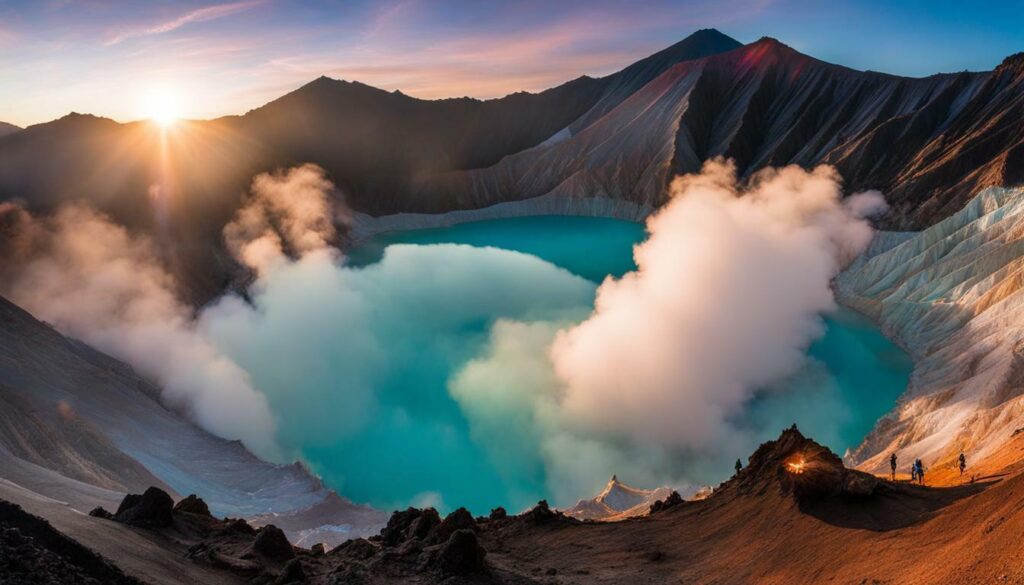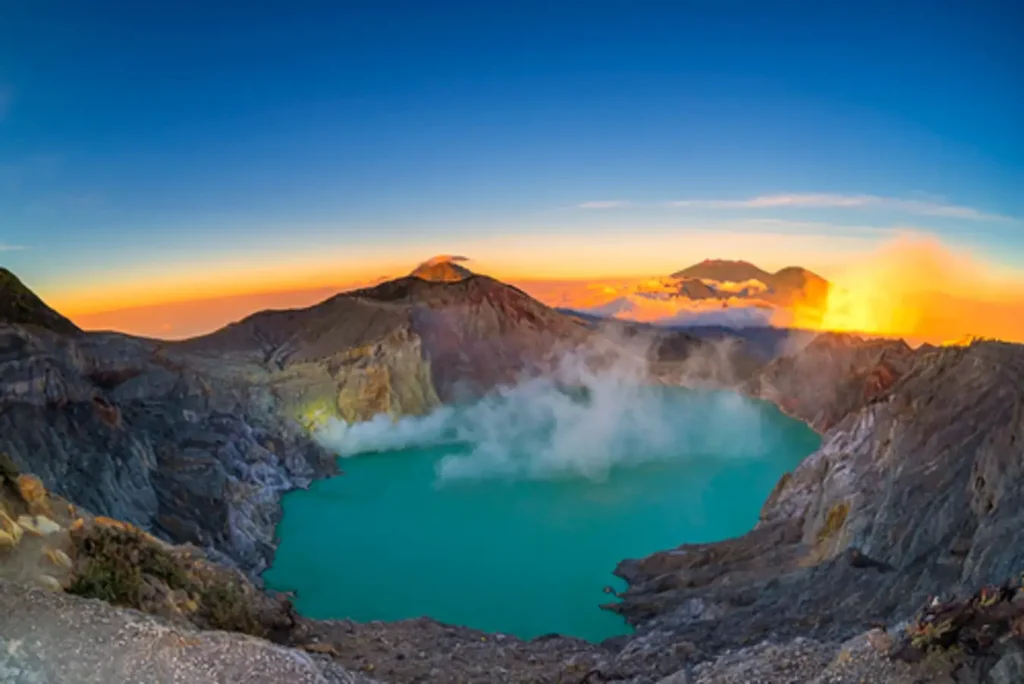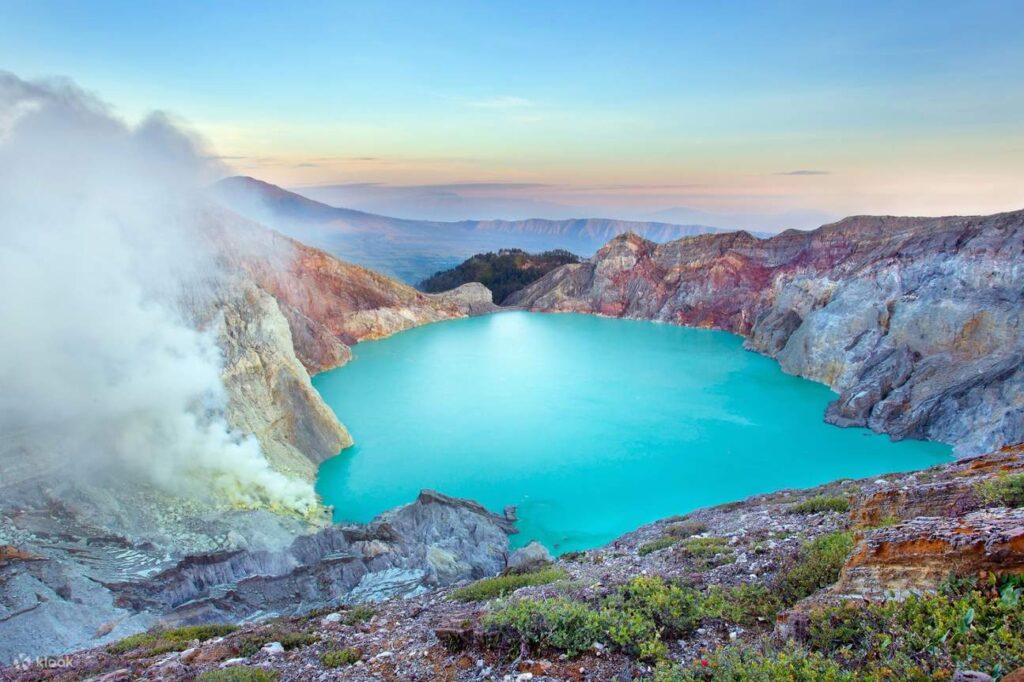Mount Ijen is a popular destination for adventurous travelers, nature lovers, and volcano enthusiasts. Located in East Java, Indonesia, this stunning mountain offers spectacular hiking trails, breathtaking views, and the famous Ijen Crater. However, understanding the weather conditions is crucial for planning your trip effectively and ensuring a memorable adventure.
In this article, we will provide you with essential information about the weather patterns you can expect when visiting Mount Ijen. From temperature and seasonal changes to rainfall and safety precautions, we will cover everything you need to know before embarking on your journey.
Key Takeaways
- Understanding the weather patterns is crucial for planning a successful trip to Mount Ijen
- The region experiences distinct wet and dry seasons, with rainfall playing a significant role
- Temperature and climate considerations are essential for climbing to the summit and exploring the Ijen Crater
- Stay updated on the weather forecast and prioritize safety precautions to ensure an enjoyable and safe experience
Exploring the Ijen Crater: What to Expect
As you plan your visit to Mount Ijen, exploring the awe-inspiring Ijen Crater is likely high on your list. The weather conditions you can expect to encounter within the crater and on the surrounding Ijen Plateau can impact your experience, so it’s essential to be prepared.
The Ijen Crater sits at an altitude of 2,799 meters, and the weather is often cooler and more temperate than the lower surrounding areas. The average temperature in the crater ranges from 10°C to 17°C, with temperatures dropping to as low as 5°C during the night. It’s essential to pack warm clothing, particularly if you plan on spending the night at the crater.
The Ijen Plateau, located at the foot of the Ijen Volcano, is known for its tropical rainforest climate. The plateau’s average temperature ranges between 22°C to 26°C, with humidity levels often high. Expect occasional rain and thunderstorms throughout the year.
What to Wear and Bring
When exploring the Ijen Crater, it’s crucial to wear comfortable, warm clothing that can withstand the cooler temperatures. Bring a good pair of hiking shoes and a headlamp or flashlight for the hike to the crater, as the trail can be dark and steep. A gas mask or respirator is also recommended to avoid inhaling the noxious sulfur gases that often fill the crater.
On the Ijen Plateau, pack lightweight, moisture-wicking clothing that is comfortable to wear in the hot and humid climate. Don’t forget a rain jacket or poncho and insect repellent, which can come in handy during the wetter months.
Best Time to Visit
The best time to visit the Ijen Crater and Plateau is during the dry season, which typically runs from May to September. During this season, the weather is generally clear, and visitors can see the stunning blue flames that illuminate the sulfur mines at night. However, keep in mind that this time of year can also be crowded with tourists.
If you prefer to avoid the crowds, consider visiting during the shoulder season from October to November or March to April. The weather can be unpredictable during this time, but the fewer visitors and lower prices may be worth the risk.
During the wet season from December to February, the area experiences heavy rainfall and frequent thunderstorms. This weather can make the climb to the Ijen Crater more challenging, but the lush greenery and stunning waterfalls can be worth the extra effort.
In summary, understanding the weather conditions on the Ijen Crater and Plateau is essential for planning a successful trip. Come prepared with appropriate clothing and gear and visit during the best time of year for your preferences. With proper planning, you can experience the natural beauty of Mount Ijen in comfort and safety.
Climbing Mount Ijen: Weather Considerations
Before starting your ascent to the summit of Mount Ijen, it is important to be aware of the weather conditions you may encounter. The climate on the mountain can be unpredictable, and the temperature can vary depending on the time of day.
The average temperature at the base of the mountain ranges from 18°C to 20°C, while at the summit, it can drop to as low as 6°C. Therefore, it is crucial to bring warm clothing, even if you start your hike in the daytime.
The climate on Mount Ijen is influenced by the altitude and the surrounding rainforest. The rainy season spans from October to March, while the dry season is from April to September. During the wet season, the trails can be slippery and challenging to navigate.
It is also essential to monitor the sulfur gas emissions from the volcano, which can fluctuate depending on the weather conditions. To ensure your safety, it is recommended to wear a gas mask during the climb.
When planning your ascent to the summit, it is crucial to consider the weather conditions carefully. Avoid climbing during a thunderstorm or when the weather is forecasted to be particularly harsh. It is advisable to check the weather forecast before beginning your ascent to the summit.
Rainfall and Seasonal Changes
Mount Ijen is located in the tropical region of East Java, Indonesia, meaning it experiences high levels of rainfall throughout the year. However, the amount of rainfall varies depending on the season.
The wet season at Mount Ijen typically occurs between October and April. During this time, rainfall levels are at their highest, and the weather can be unpredictable. If you plan on visiting Mount Ijen during this time, be sure to bring appropriate rain gear and prepare for potential trail closures due to heavy rain.
On the other hand, the dry season at Mount Ijen usually occurs between May and September. During this time, rainfall levels are much lower, and the weather is generally more favorable for hiking and exploring. However, it’s still important to keep in mind that rain can still occur during the dry season, so it’s always wise to be prepared.
Overall, rainfall is a significant factor to consider when planning a visit to Mount Ijen. Be sure to check the weather forecast before embarking on your journey and pack accordingly for the season.
Mount Ijen Weather Forecast
Keeping an eye on the weather forecast is crucial when planning a trip to Mount Ijen, as conditions can change rapidly and unexpectedly. To ensure accuracy, it is recommended to use reliable sources for weather information in the region.
One such source is the Indonesian Meteorological, Climatological and Geophysical Agency (BMKG), which provides daily weather updates for the East Java region. The agency’s website is available in both Indonesian and English and includes detailed information on temperature, humidity, wind speed, and rainfall, as well as satellite imagery and weather radar.
Another option is to use weather apps such as AccuWeather, Weather Underground, or The Weather Channel, which offer hour-by-hour and extended weather forecasts for Mount Ijen. These apps can be downloaded on both iOS and Android devices.
When checking the weather forecast, it is important to note that conditions can vary greatly between the base of the mountain and the summit. The crater area is also known for its unpredictable weather, with fog and sulfuric gas emissions frequently obscuring visibility. Visitors should stay alert to any sudden changes in weather conditions and be prepared to adjust their plans accordingly.
Safety Precautions for Mount Ijen Visitors
While Mount Ijen is undoubtedly a beautiful and awe-inspiring destination, climbing the volcano presents certain risks that visitors must be aware of. One of the most critical factors to consider is the weather, as it can change rapidly and dramatically in this area. Here are some key safety precautions to take into account:
- Check the weather forecast: Before embarking on your climb, be sure to check the latest weather forecast. Avoid going if rain or other severe weather is predicted.
- Bring appropriate clothing: Dress warmly in layers, as temperatures can drop drastically as you ascend the mountain. Wear sturdy shoes with good traction to avoid slipping on the steep terrain.
- Stay on designated paths: Avoid wandering off the designated hiking trails, as the landscape can be treacherous and unstable.
- Be aware of volcanic activity: Mount Ijen is an active volcano, and visitors should stay informed about any unusual activity or alerts from local authorities.
- Bring a mask: When entering the crater area, wear a mask to protect yourself from toxic gas emissions.
- Climb with a guide: Consider hiring a local guide who is familiar with the terrain and can provide valuable safety advice.
Remember that safety should always be your top priority when visiting Mount Ijen. By being aware of the weather conditions and following these precautions, you can ensure a safe and enjoyable experience on one of Indonesia’s most spectacular natural wonders.
Conclusion
When planning a visit to Mount Ijen in East Java, it is essential to consider the weather conditions that may impact your trip. Being aware of the temperature, rainfall, and seasonal changes will help you plan effectively and ensure an enjoyable experience.
Remember to stay updated on the Mount Ijen weather forecast before your trip, so you can make any necessary adjustments to your itinerary. Safety should always be a top priority, and understanding the potential hazards related to weather is crucial for your well-being during your adventure.
We hope this guide has provided you with valuable information on the weather conditions you can expect when visiting Mount Ijen. Enjoy the breathtaking beauty of East Java and the mesmerizing Ijen Crater, and make unforgettable memories on your journey.
Enjoy the Best of Ijen East Java Weather!
FAQ
What kind of weather can I expect when visiting Mount Ijen?
When visiting Mount Ijen, you can expect a moderate tropical climate with temperatures ranging from 8 to 25 degrees Celsius (46 to 77 degrees Fahrenheit).
How should I prepare for exploring the Ijen Crater?
When exploring the Ijen Crater, it is important to be prepared for variable weather conditions. It can be chilly and windy, so layering your clothing and bringing a windbreaker is recommended.
What are the weather considerations for climbing Mount Ijen?
Climbing Mount Ijen requires careful consideration of the weather. The average temperature on the summit is around 10 degrees Celsius (50 degrees Fahrenheit), so warm clothing is essential. Additionally, be prepared for rainfall and bring appropriate rain gear.
How does rainfall affect the weather at Mount Ijen?
Mount Ijen experiences a wet season, typically from November to April, with higher rainfall. During this time, there may be an increased chance of fog, so it’s important to take precautions and have proper visibility equipment.
Where can I find a reliable Mount Ijen weather forecast?
To stay updated on the weather conditions at Mount Ijen, you can check reliable sources such as local weather websites or consult with your tour operator. They will provide you with the most accurate forecast for the region.
What safety precautions should I take regarding the weather at Mount Ijen?
When visiting Mount Ijen, it is essential to prioritize safety. Be aware of the potential hazards related to weather, such as slippery trails during rainy conditions. Always check the forecast, bring appropriate gear, and follow the guidance of experienced guides for a safe and enjoyable experience.





